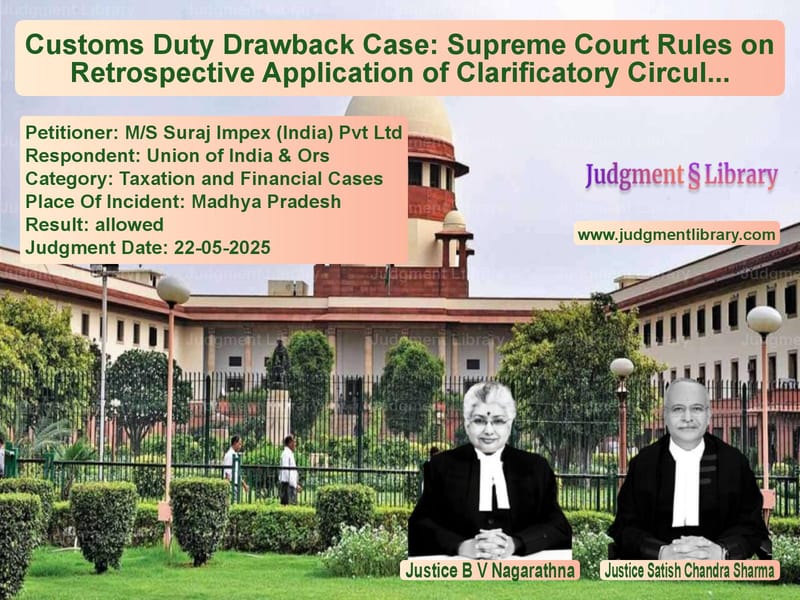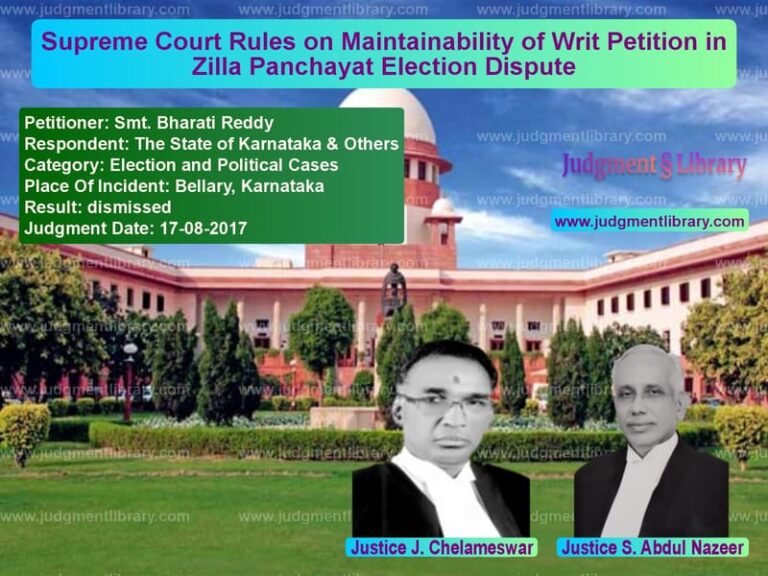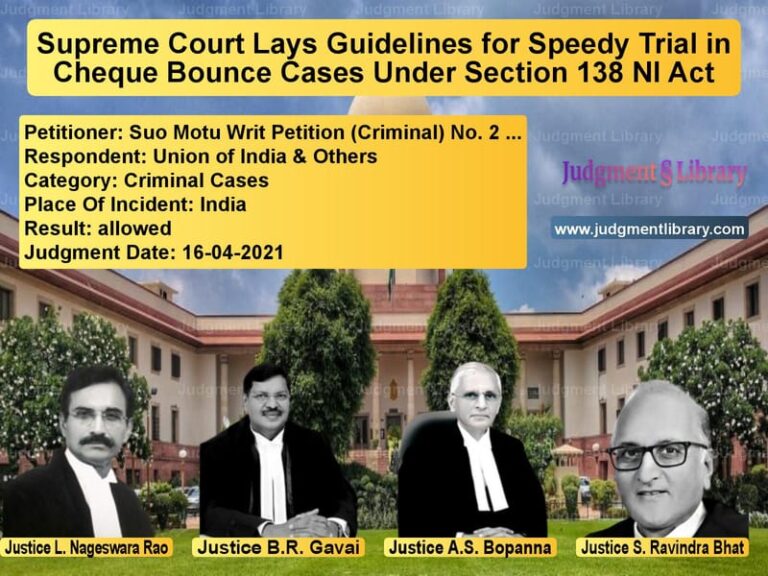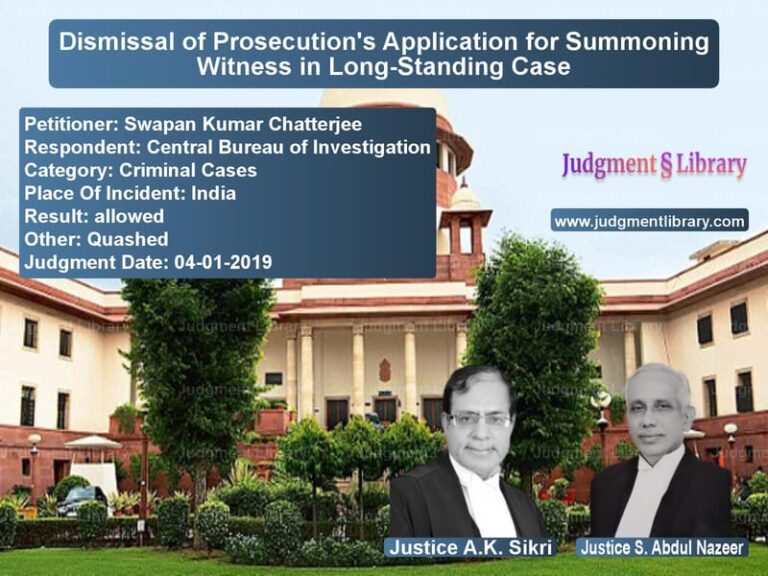Customs Duty Drawback Case: Supreme Court Rules on Retrospective Application of Clarificatory Circular
In the complex world of export regulations and tax benefits, a seemingly simple clarification from the government can mean the difference between profitability and financial strain for businesses. This was precisely the situation faced by M/s Suraj Impex (India) Pvt. Ltd., a company engaged in the export of Soyabean Meal, when they found themselves entangled in a legal battle over duty drawback benefits that would eventually reach the Supreme Court of India. The case, which revolved around the interpretation of a customs circular and its retrospective application, highlights the delicate balance between government policy and business expectations in India’s export ecosystem.
The story begins with the Appellant, M/s Suraj Impex, regularly exporting Soyabean Meal and receiving the benefit of 1% All-Industry Rate (AIR) duty drawback under various customs notifications issued between 2006 and 2010. This benefit was crucial for their business operations, helping to offset various duties and taxes paid during the manufacturing process. However, in 2008, their world was turned upside down when the Director General of Central Excise in Indore took the position that manufacturers and exporters were not entitled to this AIR drawback if they had already availed rebate of central excise duty under Rule 18 or Rule 19(2) of the Central Excise Rules, 2002.
This interpretation meant that Suraj Impex and other similarly placed merchant exporters suddenly found their duty drawback claims being withheld. The company, along with other exporters through the Federation of Indian Export Organizations, made representations to the authorities, arguing that the drawback on Soyabean Meal export was specifically for the customs component, while the benefits under Rule 18 and Rule 19(2) related to the central excise portion. They emphasized that “CBEC had itself fixed this rate uniformly at 1% for exporters whether the CENVAT facility has been availed or has not been availed because the rate is based on the Customs component of the duty incidence and the CENVAT facility has no bearing on the rebate of Customs Duty.”
The Central Board of Excise and Customs (CBEC) eventually responded to these concerns by issuing Circular No. 35/2010-Cus. dated 17.09.2010, which became the central point of contention in the case. This circular stated that the AIR duty drawback towards the customs portion as well as excise duty benefit under Rule 18 or Rule 19(2) of the Central Excise Rules, 2002 shall be available simultaneously. The Appellant argued that this circular was clarificatory in nature and simply made explicit what was already implicit in the previous notifications.
However, when Suraj Impex approached the Commissioner (Customs) Kandla seeking disbursement of AIR Duty Drawback for periods prior to September 17, 2010, their claim was denied. The authorities maintained that the circular had prospective effect only, applicable from September 20, 2010 onward. The CBEC Drawback Division reinforced this position through a communication dated January 4, 2012, stating that “the Notification No. 84/2010-Customs (N.T.) dated 17.09.2010 was made effective from 20.09.2010 and since the words are clear and have prospective effect, the request for applicability of the same retrospectively does not arise.”
Faced with this rejection, Suraj Impex approached the Madhya Pradesh High Court through Writ Petition No. 2576/2012, specifically seeking a declaration “that circular No.35/2010 Cus. dated 17.09.2010 has retrospective effect.” The company’s main contention was that this was a clarificatory and benevolent circular that should apply uniformly to all recovery proceedings related to duty drawbacks payable from 2006 to 2010.
The Respondents, representing the Union of India and various customs authorities, maintained a consistent position before the High Court. They argued that “since the Circular No. 35/2010-Cus. dt. 17.09.2010 very categorically mentioned the effective date as 20.09.2010, which is clear and prospective in nature, the question of giving retrospective effect to a statute does not arise.” They further contended that the Appellant’s product was exempted from payment of duty and didn’t fall under the CENVAT Scheme, and that the Appellant had already availed benefits under Rule 19(2) of Central Excise Rules, 2002.
The High Court agreed with the Respondents’ position and dismissed the writ petition, stating that the notification dated September 17, 2010 “was not merely to clarify the position or make explicit, an implicit issue in previous notifications and would not be applicable retrospectively as it clearly mentions that the same shall be effective from 20.09.2010.” The subsequent review petition filed by the Appellant was also dismissed at the threshold.
This led to the appeal before the Supreme Court, where the legal battle intensified. The Appellant’s counsel, Shri Arvind Datar, advanced several key arguments. He maintained that “the Circular No. 35/2010-Cus. Dt. 17.09.2010 was a clarificatory & benevolent circular issued with reference to the previous Notifications issued by the CBEC for the purposes of availing the benefit of the customs component of AIR duty drawback on the export of Soyabean Meal & De-Oiled Cake.” The Appellant argued that the circular adopted the same language as previous notifications from 2006 to 2010 and was intended to provide uniform interpretation for all recovery proceedings related to duty drawbacks from that period.
The Appellant also relied on decisions by the Commissioner (Appeals) that had applied the same circular retrospectively, observing that “the said CBEC Circular which gives a clarification to the existing law/provisions of Notification, would apply equally to any law/notifications issued earlier.” They emphasized the principle that “a beneficial Circular has to be applied retrospectively, while an oppressive circular has to be applied prospectively.”
The Respondents countered these arguments by stressing that “the said Circular No. 35/2010-Cus. dt. 17.09.2010 categorically states in the first paragraph that ‘the rates of drawback have been made effective from 20.09.2010’ and hence can in no manner be given a retrospective operation.” They argued that the circular was an explanation to Notification No. 84/2010 dated September 17, 2010, and both documents were clearly prospective in nature.
The Respondents also cited legal precedent, noting that “not all beneficial legislations are necessarily retrospective in nature,” referring to the decision in Shyam Sunder Vs Ram Kumar where it was held that “though the amending Act is a beneficial legislation meant for the general benefit of citizens but there is no such rule of construction that a beneficial legislation is always retrospective in operation, even though such legislation either expressly or by necessary intendment is not made retrospective.”
The Supreme Court, comprising Justices B.V. Nagarathna and Satish Chandra Sharma, undertook a comprehensive analysis of the issue. The Court framed the central question as “whether the Circular No. 35/2010-Cus. Dt. 17.09.2010 for the purposes of claim of custom duty drawbacks for merchant exporters, have retrospective or prospective effect.” They noted that if the circular was found to be “clarificatory, curative and declaratory in nature, its application would be retrospective.”
In their analysis, the Court emphasized that “in determining the said question, it is apposite to give credence to the substance of the Circular and not merely its form.” This approach led them to several key findings after careful examination of the circular and related documents.
The Court observed that “the Circular was issued pursuant to representations & references received by exporters who were being denied the 1% drawback of the customs portion, despite previous notifications clearly stating that the drawback was available irrespective of whether the exporter had availed CENVAT or not.” This indicated that the circular was responding to existing confusion rather than creating new policy.
Most importantly, the Court found that “a combined reading of the Circular and the Notifications issued prior thereto, would show there is no express distinction in the benefit accrued to the SBM merchant exporters from day one to the date of issuance of the circular.” They noted that “the Circular does not vest any fresh rights on merchant exporters or casts upon any burden on the Department except the one already cast upon them vide previous Notifications.”
The Supreme Court’s analysis delved deep into the nature of the circular, stating that “a threadbare analysis of the nature and substance of the CBEC Circular No. 35/2010-Cus. dt. 17.09.2010, would firstly make it evident that there is no substantive modification and amendment to the previous CBEC Notifications. The language of the Circular does not expand or alter the scope of the previous Notifications, but cements the claim of the merchant exporters, who were entitled to receive the benefit of AIR customs duty drawback since 2007.”
The Court powerfully articulated that “the Circular dt. 17.09.2010 per se clarifies and makes it explicit that the customs duties which remained unrelated to the concerned manufacturers, should be provided through the AIR drawback route, with or without the rebate of Central Excise Duties at the time of processing in terms of Rule 18 or 19 of the Central Excise Rules, 2002.”
In what would become a crucial part of their reasoning, the Court stated that “having regard to the concerned Circular dt. 17.09.2010 vis-a-vis the previous Notifications, no new right or benefit came to be created, but the actual scope of the benefit accruing to the Appellant and such similarly placed merchant exporters, was explained and settled once and for all. By virtue of the said Circular, it was merely clarified that the benefit of 1% customs duty drawback as indicated under the prior Notification was available to SBM merchants despite having availed CENVAT.”
The Court emphasized the explanatory nature of the circular, noting that “being explanatory in nature, the Circular in question cannot be construed as an adoption of a fresh fiscal regime for rebate of customs duty, intended to affect vested rights or impose new burdens upon the Department. It was passed to resolve the ambiguity qua the meaning & threshold of the previous Notifications. For the same reason, the operation of such a provision or instruction by the Department could only be retrospective in nature, so as to give effect to the objective of the Notifications issued by CBEC.”
The judgment also addressed the principle of “contemporanea exposito” or contemporaneous interpretation, noting that “the CBEC Circular dt. 17.09.2010 read in conjunction with the previous Notifications already in operation, did not confer a prospective benefit on antecedent facts, but established the scope of the very benefit introduced vide the first Notification No. 81/2006 dt. 13.07.2006 for the sake of the Appellant and such similarly placed exporters. For this simple reason, the operation of the said CBEC Circular dt. 17.09.2010 ought to be retrospective.”
While acknowledging the Respondents’ argument that “not every beneficial legislation is intended to be retrospective in nature,” the Court introduced the concept of fairness as a test, stating that “the retrospectivity of a statute is to be tested on the anvil of the doctrine of ‘fairness’. The substratum of a beneficial legislation is to ensure that the benefit is uniform and absolute, which may be prospective in nature, but when such benefit to one person does not inflict any undue burden on the other, the purposive construction can be considered to be given a retrospective effect.”
The Court concluded that “in the present case, the High Court adopted a cursory view by solely relying on the submission of the Respondents that because the subject Circular was to be made effective from 20.09.2010, it was prospective in nature. The High Court did not appreciate the rationale of the CBEC Circular nor the purport of the Notifications time and again issued by the Department and passed the Impugned Order dt. 17.11.2014 in undue haste.”
In their final ruling, the Supreme Court set aside the High Court’s judgment and held that “the Appellant is entitled to the benefit of 1% AIR Customs Duty Drawback on its export of SBM from the year 2008 as applicable, by according retrospective operation to the Circular No. 35/2010-Cus. dated 17.09.2010 issued by the Central Board of Excise & Customs, New Delhi, for the purposes of All Industry Rate (AIR) Duty Drawbacks.”
This judgment serves as an important precedent for interpreting clarificatory circulars in tax and customs matters, emphasizing that the substance and purpose of such documents must be considered rather than just their form. For exporters and businesses operating in regulated industries, the case provides clarity on when they can expect beneficial clarifications to apply retrospectively, ensuring that legitimate expectations are protected and government policies are applied consistently.
Petitioner Name: M/S Suraj Impex (India) Pvt Ltd.Respondent Name: Union of India & Ors.Judgment By: Justice B V Nagarathna, Justice Satish Chandra Sharma.Place Of Incident: Madhya Pradesh.Judgment Date: 22-05-2025.Result: allowed.
Don’t miss out on the full details! Download the complete judgment in PDF format below and gain valuable insights instantly!
Download Judgment: ms-suraj-impex-(ind-vs-union-of-india-&-ors-supreme-court-of-india-judgment-dated-22-05-2025.pdf
Directly Download Judgment: Directly download this Judgment
See all petitions in Customs and Excise
See all petitions in Tax Refund Disputes
See all petitions in Corporate Compliance
See all petitions in Contract Disputes
See all petitions in Debt Recovery
See all petitions in Judgment by B.V. Nagarathna
See all petitions in Judgment by Satish Chandra Sharma
See all petitions in allowed
See all petitions in supreme court of India judgments May 2025
See all petitions in 2025 judgments
See all posts in Taxation and Financial Cases Category
See all allowed petitions in Taxation and Financial Cases Category
See all Dismissed petitions in Taxation and Financial Cases Category
See all partially allowed petitions in Taxation and Financial Cases Category







